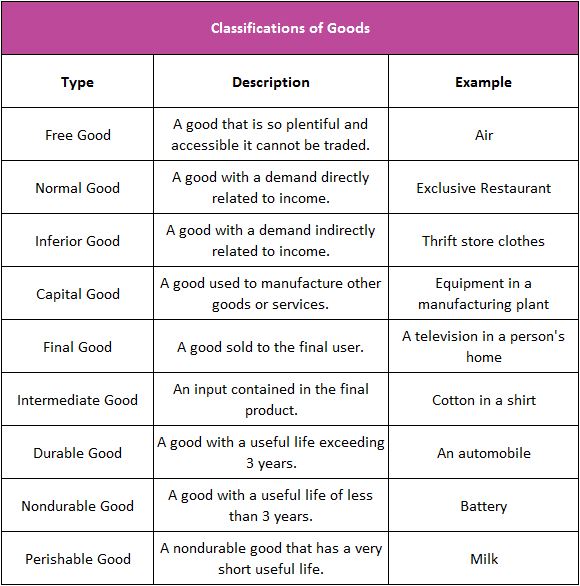Good (Economic)
View FREE Lessons!
Definition of a Good:
A
good is a tangible item that people want and are willing to purchase. Services are sometimes included with goods because they also have value and are purchased. (Our lessons treat goods and services separately.)
Detailed Explanation:
A good has value. Even free goods have value, but they are so plentiful and accessible they cannot be traded. Air is an example of a free good. Economic goods are goods people are willing to purchase because they are scarce.
Companies produce consumer goods and services for the direct consumption of consumers. A good is a tangible item that people want. Goods can be categorized as durable and nondurable. Durable goods have a life expectancy of at least three years, while nondurable goods normally last less than three years. Examples of durable goods include cars, cameras, houses, and appliances. Clothing, food, medicine, and soap are examples of nondurable goods. Perishable goods are a subset of nondurable goods. These goods are subject to decay, so they lose their value and cannot be inventoried for extended periods. Fruits, vegetables, and meat are examples of perishable goods.
“Normal” and “inferior” describe the relationship between the demand for a good or service and the buyer’s income. A normal good’s demand increases when the buyer’s income increases. Meals at exclusive restaurants are normal goods because consumers will dine more frequently at exclusive restaurants as their incomes rise. Conversely, an inferior good's demand decreases when the buyer’s income increases. Items sold at a thrift store are examples of inferior goods. Consumers may feel compelled to shop at a thrift store for used clothing to save money during periods when their income is low but purchase new clothes at department stores when their income increases.
Goods are also classified by their use. Capital goods are used to produce other goods and services. Equipment in a factory is an example of a capital good. Final goods are the goods or services sold for final consumption. Intermediate goods are contained in the final good. For example, a bed is a final good, and the springs in the bed are intermediate goods.

Dig Deeper With These Free Lessons:
Capital and Consumer Goods – How They Influence Productivity
Factors of Production – The Required Inputs of Every Business
Supply and Demand – Consumers and Producers Reach Agreement
Price Elasticity of Demand – How Consumers Respond to Price Changes
